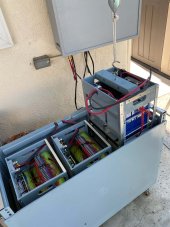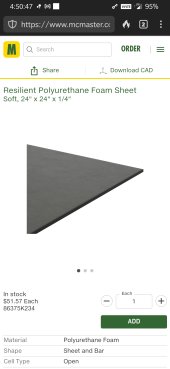well I must say reading this thread hurt my brain, and for a good 20 pages or more people seam to not understand we are dealing with gas expansion not liquid expansion so now if compressed properly there will not be the movement people think as if the volume doesn't change with a gas then pressure and temp go up. if eve is telling me I can clamp it at such a force and at such a state of charge and temp I am assuming that when I am at 100% state of charge the pressure/temp inside the cell will still be at a safe range and it won't rupture the safety disk. the only thing compression is doing is keep the week middle of the aluminum casing from bulging a bit as it is weaker than the slight rise in pressure
now if it was water expansion from freezing then yes water is a non compressible fluid so you don't have that option for temp and pressure to increase to make up for the volume, what you get is a force/temp increase at a much higher magnitude, which is the principle of hydraulics.
now for a serious question, since we are dealing with air compression and the slight change in volume from a bulge is really minimal in the overall volume of the container, why do people still figure you need to use springs to allow the container to expand, when the whole point is to hold it constant and prevent that bulging is it not?
lets look at what I am getting at
my eve 304 cells are 173.7 x 72 x 207.5 mm so we will round up to make it cleaner and make it into inches to keep the numbers reasonable. so they are approximately ,so 7x8x3, not exactly but close enough so that gives us 168 cubic inches
so if we bulge the faces 2mm on each side it will be a curved surface and not a uniform change so it would be less than the equivalent of 1mm on each size but I'll keep it at 1mm to each side to keep it simple. that will increase the width by 0.04 of an inch so we end up with 170.232 cubic inches so that's a change of 2.24 cubic inches (probably actually less than that if i did the math for the curved surface.. but good enough). so if we left the cells unclamped, or clamped in a system that will still allow the cells to move what will happen is the pressure inside of the cell will remain more constant as the gas temp increases, by compressing them all we are doing is holding the volume ridged which means as there is more off gassing inside the cell the pressure and temperature will go up as the gas compresses but to figure out that difference there are a few things you need to know. the most important is what is the make up of the gas inside the cell as you need that to get some of the information we need. and there is still the problem of the cell not being a empty chamber most of the space is taken up by solids so that reduces the volume we are looking at significantly then we need to know the rate of off gassing there is due to charge rate and temp. its not as simple as people are making it out to be and since eve has given a diagram on how to compress the cell that's what I am going with, now weather its one or 4 or 8 being compressed the force isn't going to change as your not going to get any movement if you do it properly as all you are doing is restraining the containers and the 17inch lbs or what ever the number is... is just the number you can tighten it to before you are putting to much stress on the container and having a negative effect.
so in my mind by using springs or foam that will give you are defeating the purpose of holding the container ridged and not allowing that expansion, so aside from having something that keep them from sliding around in an earthquake what is it really doing? Also from reading, and I may have been reading something wrong so if I am off base let me know, but the compression factor is most important for the initial so many cycles say 4 to 10 is what I have been kind of interpolating, so is their any point aside from holding them still for the busbars after that?
for mine I use them in a mobile application (rv) so yeas I want to hold them together but I also have them clamped so the busbars don't get excessive movement when charging and discharging. All I did is put the little Seperator sheets in-between the cells for a little protection and clamped them between two aluminum plates till they were snug, I would guess around 15 inch lbs in 3 years my original 280AH has never had a bus bar loosen up or anything so its doing the purpose I am using it for.






